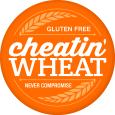Gluten is a combination of two proteins, glutenin and gliadin, that are found in wheat and related grains such as spelt, barley and rye. While traditional baking utilizes gluten for structure, texture and stability, gluten-free baking must employ many different flours/grains to achieve the same result. These flours come from a variety of sources such as rice, corn, beans, roots, grasses, nuts and seeds. All have different tastes, textures and nutritional advantages – not to mention the role they play in baked goods.
No! We wanted our Cheatin' Wheat Gluten Free Flour to be truly all-purpose. The amount of xanthan gum you need varies according to the application. For example, I do not add any xanthan gum to the flour when I make a roux for gumbo or make fried chicken. And I add a different amount of xanthan gum for cookies, cakes and breads. Think of xanthan gum like salt, you want to be able to control the amount in order to get the best results. Therefore, it should not be included in an all-purpose flour blend.
Yes, our line of gluten free dry mixes contains the appropriate amount of xanthan gum in the mix. We know you are going to make a chocolate cake with our gluten free chocolate cake mix, a muffin with our gluten free muffin mix, etc. There is no guess-work and the mixes are ready for you to use. The only Cheatin' Wheat product that does not contain xanthan gum is our gluten free all-purpose flour.
Although it is obvious when a product is made using wheat flour, gluten exists in our food system in many forms. You must scrutinize all labels for things such as binders, malt, caramel coloring, natural and artificial flavorings, modified food starch, etc. New food labeling laws are making it easier to determine what is in that packaged product. The FDA requires manufacturers to list all of the top eight allergens when present. They include milk, eggs, fish, Crustacean shellfish, tree nuts, peanuts, wheat and soybeans. It is important to note that barley, rye and oats will not be called out and these may be sources of gluten in the product.
Despite it's name, buckwheat is not related to wheat at all and is safe for a gluten free diet.
While oats themselves do not contain gluten, many brands are contaminated with wheat or barley during the manufacturing process making them unsafe to eat. The good news is there are several varieties of gluten free oats available that ensure cross-contamination has not occurred. Just make sure your label says "Gluten Free."
Our preferred rolling flour is sweet rice flour, also know as sticky rice flour and glutinous rice flour. It does not contain gluten so do not be fooled by the misleading name. Sweet rice flour resembles powdered sugar in texture so you will not get a gritty film on the outside of your dough. It is very finely ground and neutral in flavor, making it the perfect choice for rolling out gluten free pie dough.
We as consumers tend to link gluten free with any products that do not contain wheat flour. However, gluten can be found in several grains, including rye, barley and spelt. This means a product containing one of those ingredients could be wheat free but not gluten free. A great example of this is Kellog's Rice Krispies. The cereal does not contain any wheat, but does contain malt flavor which is made from barley. This product is wheat free, but not gluten free. Kellogs does offer a gluten free version of their cereal, where they leave out the barley malt, but it is not available at all locations.
Gums are hydrocolloids. Easy for me to say! Very simply that means they are large molecules that interact with water or other liquid ingredients. In gluten free baking, gums are added to recipes to mimic the elasticity, chewy texture, and viscosity the protein gluten provides in traditional baked goods. Xanthan gum is typically created by fermenting corn sugar with the bacteria Xanthomonas campestris. The resulting substance is then dried and ground up into a powder. It is the most popular gum used in gluten free foods where it acts as a binder and helps to minimize the lack of “stretch” typically provided by gluten. A very small amount of xanthan gum is required to positively impact the texture and binding properties of finished products.
Weighing ingredients is the first step in ensuring accurate baking results. We assume 1 cup of our Cheatin' Wheat Gluten Free Flour Mix weighs 4.6 oz or around 130 grams. However, if you have been making the same recipes for years scooping a heavier cup of flour, converting to our measurement may cause some difficulties. For best results, we encourage everyone to figure out their average scoop weight for one cup of flour.
For almost almost all of our dry mixes, you use the whole box in order to complete the recipe. This means there is no sifting required in order to measure the correct amount. If you are using our All-Purpose Gluten Free Flour, it is a good idea to fluff the flour or spoon into a measuring cup to get an accurate scoop. You should not need to sift, but dry mixes can get compacted over time. Therefore you end up adding more than you need to a recipe potentially resulting in dry products.
Our Vegan Chocolate Cake Mix uses certified vegan sugar. Although many people presume all sugar is naturally vegan, many brands use animal bone char as a filtering agent in the refining process. For more information, you can visit the following resource.
Baking powder and baking soda are both chemical leavening agents. This basically means they make baked goods rise by creating air bubbles when mixed and these bubbles expand when baked. Baking soda is plain ol' sodium bicarbonate and needs an acid to activate (remember your third grade science volcano?). Baking powder is baking soda with the acidic component built in; usually in the form of cream of tartar. This means that all you have to do to activate it is get it wet.
If a recipe calls for baking soda and you only have baking powder available, use about twice as much as the recipe calls for. It may not be perfect, but it will be close.
This substitution is a little trickier. If you happen to have cream of tartar on hand, you can make your own batch of baking powder. Use 2 parts baking soda to 1 part cream of tartar; mix well; measure like you would any baking powder. If all you have is baking soda, then you need to evaluate the recipe to see if it contains enough acidic ingredients to activate the baking soda. If so, try reducing the amount by approximately half.
Double acting baking powder is baking powder with the addition of sodium aluminum sulfate. This extra additive causes a second reaction of bubbles when heat is applied (in the oven).
Yes, our line of gluten free dry mixes contains the appropriate amount of xanthan gum in the mix. We know you are going to make a chocolate cake with our gluten free chocolate cake mix, a muffin with our gluten free muffin mix, etc. There is no guess-work and the mixes are ready for you to use. The only Cheatin' Wheat product that does not contain xanthan gum is our gluten free all-purpose flour.






 Find our products
Find our products FAQs
FAQs Testimonials
Testimonials R&D Projects
R&D Projects